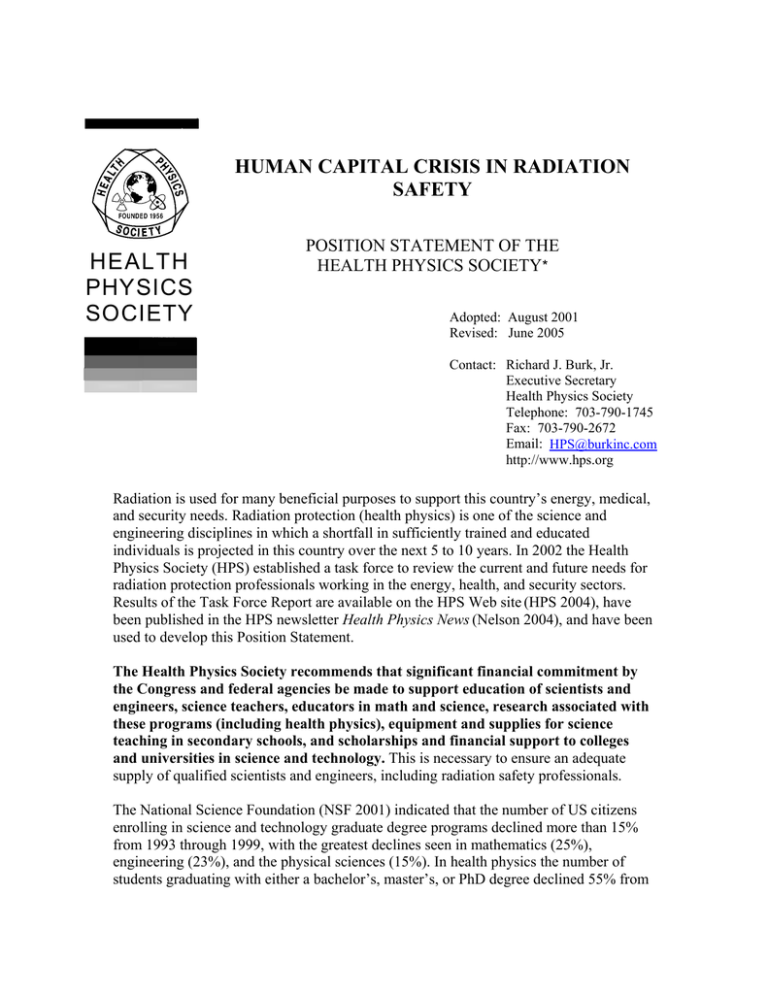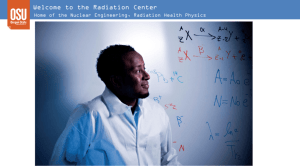HEALTH PHYSICS SOCIETY
advertisement

HUMAN CAPITAL CRISIS IN RADIATION SAFETY HEALTH PHYSICS SOCIETY POSITION STATEMENT OF THE HEALTH PHYSICS SOCIETY* Adopted: August 2001 Revised: June 2005 Contact: Richard J. Burk, Jr. Executive Secretary Health Physics Society Telephone: 703-790-1745 Fax: 703-790-2672 Email: HPS@burkinc.com http://www.hps.org Radiation is used for many beneficial purposes to support this country’s energy, medical, and security needs. Radiation protection (health physics) is one of the science and engineering disciplines in which a shortfall in sufficiently trained and educated individuals is projected in this country over the next 5 to 10 years. In 2002 the Health Physics Society (HPS) established a task force to review the current and future needs for radiation protection professionals working in the energy, health, and security sectors. Results of the Task Force Report are available on the HPS Web site (HPS 2004), have been published in the HPS newsletter Health Physics News (Nelson 2004), and have been used to develop this Position Statement. The Health Physics Society recommends that significant financial commitment by the Congress and federal agencies be made to support education of scientists and engineers, science teachers, educators in math and science, research associated with these programs (including health physics), equipment and supplies for science teaching in secondary schools, and scholarships and financial support to colleges and universities in science and technology. This is necessary to ensure an adequate supply of qualified scientists and engineers, including radiation safety professionals. The National Science Foundation (NSF 2001) indicated that the number of US citizens enrolling in science and technology graduate degree programs declined more than 15% from 1993 through 1999, with the greatest declines seen in mathematics (25%), engineering (23%), and the physical sciences (15%). In health physics the number of students graduating with either a bachelor’s, master’s, or PhD degree declined 55% from 270 students in 1995 to 122 in 2002. In addition, the number of health physics programs graduating at least 5 students annually decreased from 20 programs in 1995 to 7 programs in 2002. Zumeta and Raveling (Zumeta and Raveling 2003) identified “very modest compensation for graduate students and postdoctoral appointees” as one reason that science and technology careers are considered less attractive. Support for research and teaching has historically come from the federal government, but recently this support has dwindled. Federal support is needed because scientific and engineering education is in the national interest and promotes the common good and national security. The human capital crisis continues to deepen; while needed enrollments and focused academic and training programs shrink, the need for well-educated and trained graduates is intensifying. In the federal government alone human capital issues were felt in all agencies according to a recent Government Accountability Office report (Walker 2001). It was anticipated that 35% of the fiscal year 1998 federal workforce will be eligible for regular retirement by 2006. Well-educated people in science and technology are needed to meet growing needs in industry, government (NRC, EPA, DOE, etc.), medicine, and homeland defense and in order for the United States to continue to be a world leader in science and technology. Strong, healthy academic programs are needed to continue to provide a meaningful succession of scientists and engineers and this includes radiation protection professionals working in the energy, regulatory/security, and health sectors of our nation. A report published by the Nuclear Engineering Department Heads Organization (NEDHO 2000) stated that enrollment in nuclear engineering programs has been declining since 1992. Recently, demand for nuclear scientists has outstripped supply. Furthermore, with expanding uses of radiation in diagnostic and therapeutic medical applications and the potential expansion of nuclear technology to meet the nation’s future energy needs, it is clear to the radiation safety community that the current imbalance between supply and demand will significantly worsen in the near term, after which it will soon become untenable. The shortage of qualified radiation safety professionals will compromise the rigorous oversight necessary for the continued safe use of radiation for the benefit of the citizens of the United States. A conservative total of approximately 6,700 radiation protection professionals from all employment sectors combined has been identified in the Task Force Report. This value does not include, for example, part-time or consulting radiation protection professionals. Strong, healthy academic programs are necessary to ensure a continuing supply of radiation protection professionals working in these critical employment sectors. Although the remaining health physics academic programs have the potential to expand and meet the current demand for graduates in health physics, this potential cannot be realized without rapid and substantial investment. The HPS has, for many years, provided support to students in health physics and encouraged standardization and accreditation in health physics education and training. Many members of the Society donate time and effort to health physics academic programs, in addition to their substantial effort in providing radiation fundamentals training to science teachers. The HPS has also explored private sources of funding for health physics academic programs and actively encourages students to become interested in health physics programs. However, the critical human capital shortage in radiation safety is overwhelming the Society’s efforts to help respond to this crisis. REFERENCES Health Physics Society. Human capital crisis task force report, July 2004 [online]. Available at: http://hps.org/documents/ManpowerTaskForceReport.pdf. National Science Foundation, Division of Science Resources Studies. Graduate students and postdoctorates in science and engineering: Fall 1999. Arlington, VA: National Science Foundation; NSF 01-315; 2001. Nelson K. Human capital crisis report. Health Physics News 9:18-19; 2004. Nuclear Engineering Department Heads Organization. Manpower supply and demand in the nuclear industry. Nuclear Engineering Department Heads Organization; 2000. Walker D. Meeting the governmentwide high-risk challenge. Testimony presented before the US Senate Subcommittee on Oversight of Government Management, Restructuring and the District of Columbia Committee on Governmental Affairs, GAO-01-357T, US General Accounting Office, 1 February 2001. Zumeta W, Raveling JS. Attracting the best and brightest. Issues in Science and Technology Winter 2002-03:36-40; 2003. *The Health Physics Society is a nonprofit scientific professional organization whose mission is to promote the practice of radiation safety. Since its formation in 1956, the Society has grown to approximately 6,000 scientists, physicians, engineers, lawyers, and other professionals representing academia, industry, government, national laboratories, the Department of Defense, and other organizations. Society activities include encouraging research in radiation science, developing standards, and disseminating radiation safety information. Society members are involved in understanding, evaluating, and controlling the potential risks from radiation relative to the benefits. Official position statements are prepared and adopted in accordance with standard policies and procedures of the Society. The Society may be contacted at 1313 Dolley Madison Blvd., Suite 402, McLean, VA 22101; phone: 703-790-1745; fax: 703-790-2672; email: HPS@BurkInc.com.




